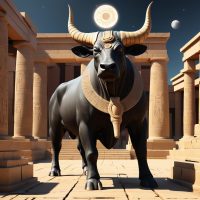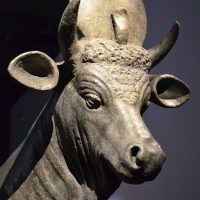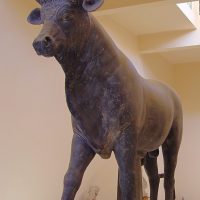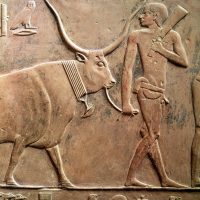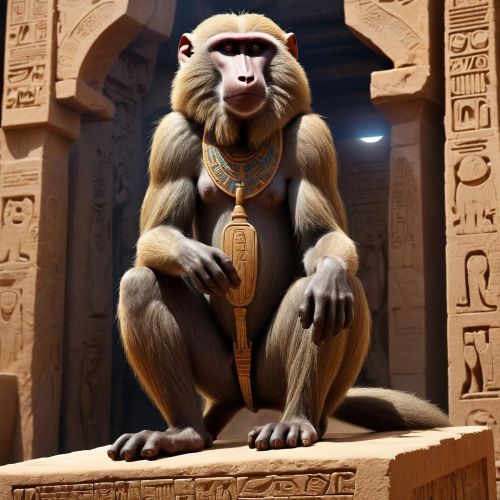Apis : The Sacred Bull
Listen
At a glance
| Description | |
|---|---|
| Origin | Egyptian Mythology |
| Classification | Animals |
| Family Members | Hathor (Mother) |
| Region | Egypt |
| Associated With | Fertility, Strength |
Apis
Introduction
Apis, known in ancient Egyptian as Hapi or Hapis, was among the most venerated deities in Egyptian mythology. Represented as a sacred bull, Apis embodied fertility, vitality, and divine authority. His worship, centered in the city of Memphis, dates back to the early dynastic period, around 3150 BCE. Over centuries, Apis evolved from a local fertility symbol into one of Egypt’s most significant divine figures, serving as the living manifestation of the creator god Ptah and later merging with Osiris, the god of the underworld. Through this transformation, Apis came to represent the eternal cycle of life, death, and rebirth, mirroring Egypt’s enduring fascination with immortality and divine kingship.
Physical Traits
The Apis bull was recognized by distinctive physical characteristics that marked it as divine. Egyptian priests sought a black bull with specific white markings, a white triangle on its forehead, a crescent moon on its side, and a scarab-shaped mark under its tongue. These sacred signs identified the bull as the living vessel of Ptah. Sometimes, Apis was depicted wearing a solar disk and a uraeus (cobra) between its horns, symbolizing the bull’s connection to the sun god Ra and the authority of the pharaoh. Once discovered, the chosen Apis bull was taken to the temple of Ptah in Memphis, where it lived in luxury, receiving offerings and daily rituals performed by high priests. Its well-being was of national importance, as the bull was considered the physical link between the divine and mortal worlds. In art, Apis appeared either as a robust bull or a man with a bull’s head, signifying both power and sacred duality.
Family
In mythology, Apis held a unique position within the Egyptian divine family. He was primarily regarded as the earthly manifestation or son of Ptah, the great craftsman and creator god of Memphis. Some traditions describe his conception through a miraculous event—Ptah impregnated a sacred cow with a lightning bolt or a ray of moonlight. The mother cow was revered as the “Isis cow,” an embodiment of Hathor, the goddess of motherhood and fertility. Through his association with Hathor, Apis also became a symbol of maternal protection and abundance. After death, the divine bull’s spirit merged with Osiris, the ruler of the underworld, becoming Osorapis or Serapis, a deity representing resurrection and eternal life. This connection between Ptah, Apis, and Osiris formed a sacred triad symbolizing creation, life, and rebirth, essential to Egypt’s religious philosophy.
Other names
Throughout Egyptian history, Apis was known by several names and titles reflecting his divine attributes and evolving worship. In early texts, he was called Hap or Hep, with “Apis” being the Greek adaptation of his name. He was also referred to as Hapi-ankh, meaning “Living Apis,” emphasizing his role as a living deity. In funerary contexts, he was sometimes called “Bull of the West,” a title that linked him to the journey of the dead toward the afterlife. When Greek and Egyptian beliefs merged during the Ptolemaic period, Apis was integrated into the composite deity Serapis, depicted as a human with divine bull attributes. This Greco-Egyptian god became widely worshipped in Alexandria and throughout the Hellenistic world, symbolizing the fusion of Egyptian spirituality with Greek philosophy.
Powers and Abilities
Apis was revered for his extraordinary powers that extended across both the natural and spiritual realms. As a fertility god, he ensured agricultural prosperity, abundant livestock, and the generative power of the Nile. His presence was believed to invigorate the land and strengthen the people’s vitality. Beyond fertility, Apis functioned as a living oracle. Priests observed his movements, behaviors, and reactions to questions as divine messages, interpreting them to guide royal and state decisions. In one legend, those who inhaled the breath of Apis gained prophetic insight, further reinforcing his role as a conduit between gods and mortals.
Following his death, Apis’s divine essence was believed to merge with Osiris, transforming him into Osorapis, a protector of souls in the afterlife. The dead invoked his power for safe passage and resurrection. His protective horns frequently appeared on royal sarcophagi and tomb decorations, serving as symbols of strength, guidance, and eternal protection. In temple rituals, Apis was also invoked to bless kings, affirming their legitimacy and divine right to rule. His power represented the union of physical vitality and spiritual immortality a theme central to Egyptian religious thought.
Modern Day Influence
The influence of Apis extends far beyond ancient Egypt, continuing to captivate modern scholars, archaeologists, and spiritual seekers. The Serapeum of Saqqara, an underground necropolis where the mummified remains of sacred Apis bulls were buried, stands as one of Egypt’s most impressive archaeological sites. Excavated by Auguste Mariette in 1850, the Serapeum revealed massive granite sarcophagi, some weighing over 60 tons testifying to the grandeur of the Apis cult and the extraordinary engineering prowess of ancient Egyptians. The inscriptions, artifacts, and architecture found there provide invaluable insight into Egypt’s religious practices and its reverence for sacred animals.
In modern interpretations, Apis continues to be studied as a powerful example of animal worship and divine kingship. His imagery of strength and virility has persisted in cultural symbols and branding across the world. The very word “Apis,” meaning “bee” in Latin, has been adopted in scientific nomenclature, most notably in Apis mellifera, the honeybee species demonstrating how ancient names can carry enduring symbolic weight across different fields.
Cultural comparisons also highlight Apis’s influence beyond Egypt. Scholars often draw parallels between Apis and other sacred bulls, such as India’s Nandi, mount of Lord Shiva, and Mesopotamia’s Bull of Heaven, reflecting shared ancient beliefs in divine animal intermediaries. Moreover, the biblical story of the Golden Calf may have been inspired by the Apis cult, as the Israelites, once enslaved in Egypt, would have been familiar with the rituals surrounding the sacred bull.
In today’s Egypt, the legacy of Apis survives in historical tourism and museum exhibits, where sculptures, reliefs, and mummified remains remind visitors of the civilization’s deep reverence for the divine in all living forms. Apis remains a symbol of life’s cyclical nature of strength renewed through death, of fertility intertwined with faith, and of humanity’s eternal desire to commune with the divine.
Related Images
Source
Egypt Mythology. (2024, September 28). The Apis Bull: Myths of Strength and Protection. Retrieved from https://egyptmythology.com/the-apis-bull-myths-of-strength-and-protection/
Wikipedia contributors. (2025). Apis (deity). Wikipedia. Retrieved from https://en.wikipedia.org/wiki/Apis_%28deity%29
Mark, J. J. (2017, April 21). Apis. World History Encyclopedia. Retrieved from https://www.worldhistory.org/Apis/
Mariette, A. (1857). Le Sérapéum de Memphis. Paris: Imprimerie Nationale.
Hornung, E. (1999). The Ancient Egyptian Books of the Afterlife. Cornell University Press.
Brunet, J.-F. (2005). The XXIInd and XXVth Dynasties Apis Burial Conundrum. Journal of the Ancient Chronology Forum, 10, 26-34.
Budge, E. A. W. (1969). The Gods of the Egyptians, Vol. 2. Dover Publications.
Ibrahim, M., & Rohl, D. (1988). Apis and the Serapeum. Journal of the Ancient Chronology Forum, 2, 6-26.
Mariette, A., & Vandier, J. (1961). Memphis et le taureau Apis dans le papyrus Jumilhac. In J. S. F. Garnot (Ed.), Mélanges Mariette (pp. 123-145). Cairo.
Thompson, D. J. (2012). Memphis Under the Ptolemies (2nd ed.). Princeton University Press.
Vos, R. L. (1992). The Apis Embalming Ritual: P. Vindob. 3873. Leuven: Peeters Publishers.
Frequently Asked Questions
What is lorem Ipsum?
I am text block. Click edit button to change this text. Lorem ipsum dolor sit amet, consectetur adipiscing elit. Ut elit tellus, luctus nec ullamcorper mattis, pulvinar dapibus leo.
What is lorem Ipsum?
I am text block. Click edit button to change this text. Lorem ipsum dolor sit amet, consectetur adipiscing elit. Ut elit tellus, luctus nec ullamcorper mattis, pulvinar dapibus leo.
What is lorem Ipsum?
I am text block. Click edit button to change this text. Lorem ipsum dolor sit amet, consectetur adipiscing elit. Ut elit tellus, luctus nec ullamcorper mattis, pulvinar dapibus leo.
What is lorem Ipsum?
I am text block. Click edit button to change this text. Lorem ipsum dolor sit amet, consectetur adipiscing elit. Ut elit tellus, luctus nec ullamcorper mattis, pulvinar dapibus leo.
What is lorem Ipsum?
I am text block. Click edit button to change this text. Lorem ipsum dolor sit amet, consectetur adipiscing elit. Ut elit tellus, luctus nec ullamcorper mattis, pulvinar dapibus leo.


